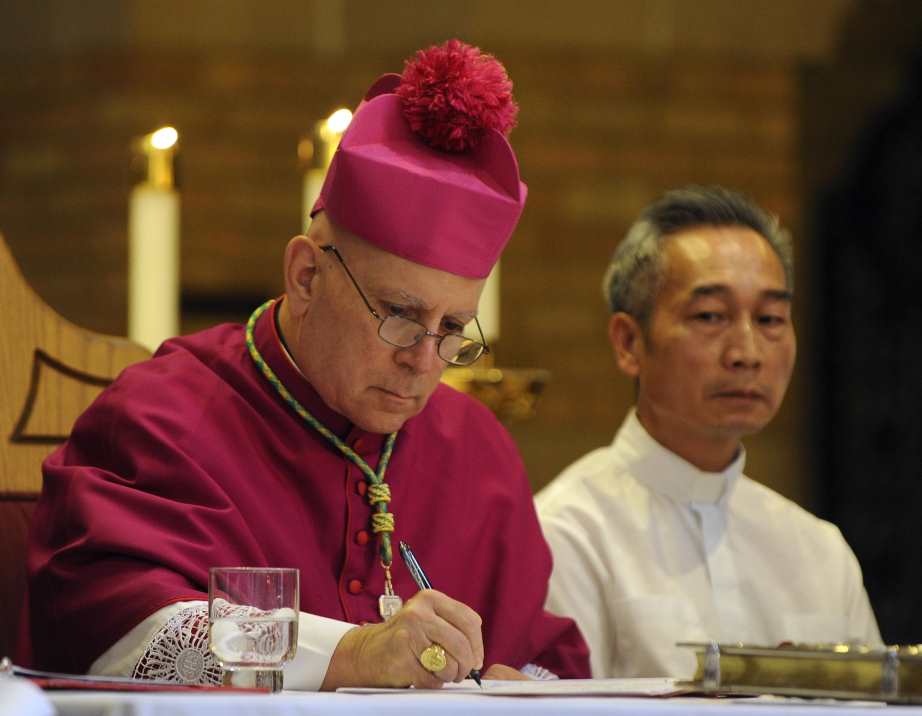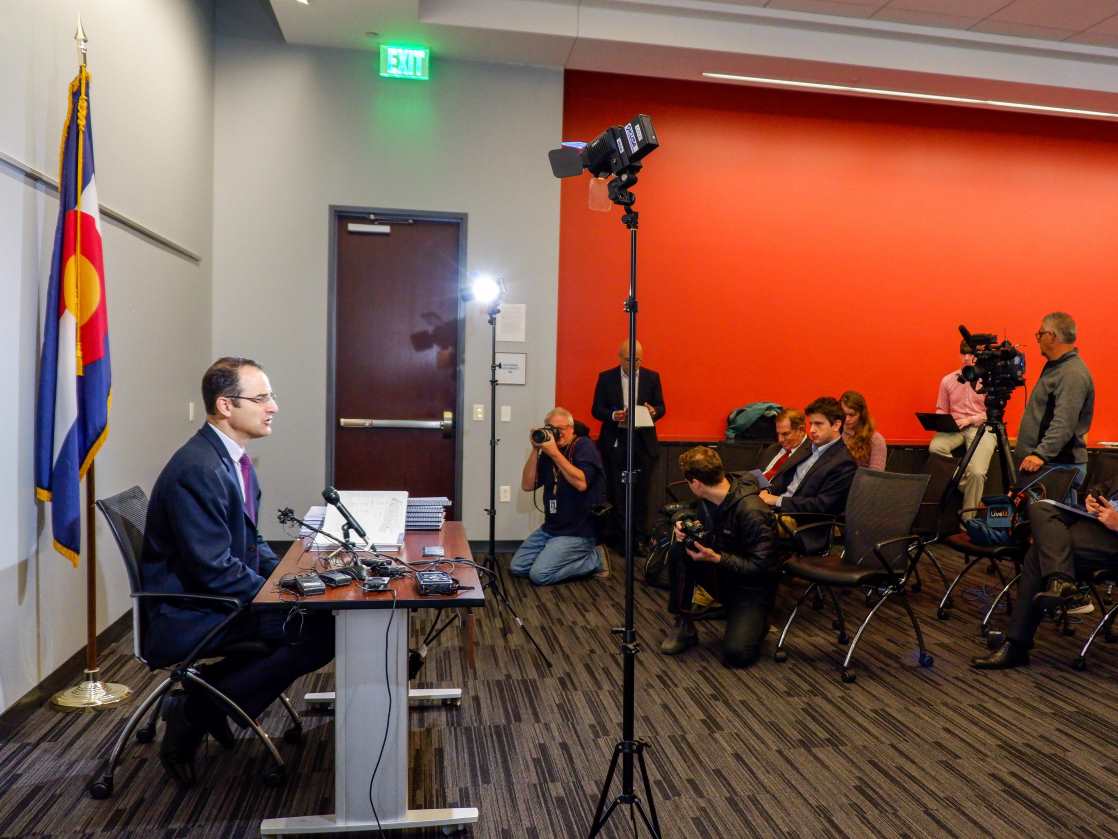|
At least 166 children have been sexually abused by Catholic priests in Colorado since 1950, new report finds
By Jennifer Brown And Jesse Paul
[with video] Catholic priests in Colorado sexually abused at least 166 children since 1950, according to a damning, 263-page report released Wednesday by an independent investigator who found the church expunged files and covered up abuse for decades. It took nearly 20 years on average for the church to stop an abusive priest after receiving an abuse allegation, and more than half of the child victims were sexually abused after the diocese was aware that the priests were abusers, the review found. The report accuses 43 priests, but most of the abuse was committed by five. In the Denver archdiocese, three priests alone abused at least 90 children. The report said there were 100 instances in which the church could have reported abuse to police dating back to 1950, but did so fewer than 10 times. The findings come after a seven-month investigation into the church led by Colorado’s former U.S. attorney, Bob Troyer, and after an agreement between the state’s attorney general and the Denver, Colorado Springs and Pueblo dioceses. The report is the most comprehensive accounting of abuse by Catholic priests in Colorado to date and comes after similar reckonings elsehwhere in the nation. The investigation — which was paid for by a private, anonymous donor — did not find any priests currently in ministry who have been credibly accused of abusing children, though the report cautioned that “we cannot be positive there are none.” It was not a grand jury investigation, unlike the Pennsylvania report in 2018 that listed 301 priests. “Our review revealed flaws in the Colorado dioceses’ records and practices that make it impossible to honestly and reliably conclude that no clergy child sex abuse has occurred in Colorado since 1998 — or that no Colorado Roman Catholic priests in active ministry have sexually abused children or are sexually abusing them,” the report said. Sex abuse by priests in Colorado peaked in the 1960s, the report concluded. The most recent cases uncovered by the review were in 1990 and 1998, as well as two instances since 2000 of priests “grooming” a child for abuse. “This is a dark and painful history,” Attorney General Paul Weiser said as he released the report, noting it will be updated and encouraging other victims to come forward. “The culture going back decades was one where there was a reluctance to admit wrongdoing.” He added: “It’s unimaginable, and the most painful part for me is we have had stories told of victims coming forward and they weren’t supported. We can’t make up for that. What we can do is build a culture that, going forward, when people come forward and tell their stories they are supported.” Investigators cautioned that it should “not be taken as an exhaustive compilation of every incident of clergy in Colorado sexually abusing children over the last 70 years.” The investigation also did not chronicle abuse committed by religious-order priests in Colorado or by priests before they were ordained, or sexual misconduct against adult victims. Colorado’s Catholic dioceses have put together a settlement fund for those who were sexually abused by priests, and several victims have already applied for benefits. The investigation did not yield any recommended prosecutions, as the abuse cases uncovered are either outside of the state’s statute of limitations or, in one case, have already been reported to authorities. Reporting of priest abuse to law enforcement is not required if the victim is an adult at the time they come forward and if the priest is no longer “in a position of trust with children.” The investigation found multiple “missed opportunities for justice and healing” because a diocese failed to voluntarily report sex abuse to police. Church officials have “gradually improved” documentation, but “they must continue to evolve,” the report said. Files from the 1980s were purged of sex abuse allegations. Before the 1990s, the Colorado dioceses “often intentionally did not document child sex abuse allegations or referred to them in such euphemistic terms that they were completely obscured,” investigators wrote, noting that this was similar to other dioceses throughout the country. An anal rape of a 12-year-old boy was documented as a “boundary violation.” Nearly 10 child sex assaults by a priest straight out of seminary were documented as “boy troubles.” A serial child sex abuser was said to suffer from “nervousness.” “Our review confirmed the Roman Catholic Church’s long history of silence, self-protection, and secrecy empowered by euphemism,” investigators wrote. “In the past, the Colorado dioceses have deployed elusive, opaque language to shroud reports and their knowledge of clergy child sex abuse.” The investigation also found numerous examples of Colorado dioceses transferring child sex abusers “just ahead” of when documentation would have been required. This practice occurred in Colorado as recently as 1998, the review found. Problems with reporting persist, the report said. Investigators found recent examples of victims trying to report abuse and “receding back into the shadows when confronted with the flaws” in the church’s response systems. Archbishop Samuel Aquila responded to the report by speaking directly to Catholics in an eight-minute video and a four-page letter. “We recognize how difficult it is for survivors of abuse to share their stories, and we thank all of you for your courage,” Aquila wrote. “We must face the past and learn from it, and we must know if our children are safe today. Thanks to our ongoing vigilance, they are.” Mark Haas, director of public relations for the Archdiocese of Denver, said the archdiocese is a different place than it was decades ago. “Despicable things happened in our parishes, and at the time there were incredible failures to properly address them,” he said in an email. “We have taken huge steps to address this issue, and the report documents the dramatic decrease in known substantiated allegations.” One of the priests named in the report, Rev. Leonard Abercrombie, abused at least 18 boys from 1946 to 1972. The full scope of his crimes is unknown, since new victims have come forward as recently as this year. Abercrombie worked in the Denver diocese but was assigned to several rural parishes and often worked at Camp St. Malo, a summer camp for boys in Allenspark. He abused boys on overnight camping trips, where he took them to his camping trailer in remote locations, according to the report. Denver diocese files show officials knew he was abusing children as early as 1962 and that he took a sabbatical from 1962-64. He left the archdiocese in 1972 to become a hospital chaplain for the Veterans Administration. The files contains “almost no information” about why he was moved, the report said. Instead, his file contains a doctor’s note saying Abercrombie was suffering from “ill health and fatigue” and “excessive automobile” driving. Abercrombie died in 1994. Another abuser was Rev. Harold Robert White, who the report said “was the most prolific known clergy child sex abuser in Colorado history.” He abused at least 63 children in six parishes over a span of at least 21 years starting in 1960. Despite reports of abuse, the church did nothing and often shuffled White around to avoid detection and embarrassment, the report says. “When he had sexually abused enough children at a parish that scandal threatened to erupt, the Denver Archdiocese moved him to a new one geographically distant enough that White was not known there,” the report said. “The Denver Archdiocese repeated this cycle at least six times and never once restricted his ministry, or removed him from ministry, or sent him off for genuine psychiatric evaluation and care.” Investigators found that the Denver Archdiocese never did a full accounting of his behavior and never voluntarily reported him to the police. “The Denver Archdiocese was frequently dishonest with White’s victims, their parishioners, and the public about his child sex abuse and the Denver Archdiocese’s knowledge of it,” the report said. “White’s file reveals the Denver Archdiocese did all this for decades, deploying euphemism and secrecy to protect itself.” White was permanently removed from the ministry in 1993 and formally defrocked in 2004. He died in 2006. Most of the abuse cases listed in the report were from the Denver diocese, with 127 children victimized by 22 priests. Investigators said they uncovered 22 incidents of child sex abuse by clergy in the Denver diocese on their own, independent of church files. They found 36 children were abused in the Pueblo diocese by 19 priests, and three children in the Colorado Springs diocese by two priests. The majority of victims were boys between 10 and 14 years old when they were abused. Only 10% of the victims were girls. The report found that 53% of the abuse happened in the 1960s. Just two cases were reported to have happened between 2000 and present day. In all, 40 priests are named in the report. Three who were accused of grooming children for abuse were not named. Investigators noted that sex abuse reports to church personnel often were not sent up the chain to church hierarchy or law enforcement. One priest whose file was reviewed wrote, “I am overwhelmed by the onus of having to report brother priests.” The church in the past several years has revamped various policies, including the psychological evaluation of aspiring priests, to put up a protective wall against abuse. The Denver archdiocese has a victims assistance director, whose job is to respond to victims who come forward alleging abuse. While some of those policies were praised as progress, they were also criticized by investigators, who offered a list of recommendations for the church. The investigation found serious flaws in the Denver archdiocese’s “conduct response team,” which interviews a victim and decides whether the allegation is credible, what type of care the dioceses should offer and what the archbishop should do regarding the accused priest. The church bills the team interview as a healing event where the victim has a chance to tell their story to the church. Investigators disagreed, however. “The victim interview is not primarily a healing space in which to cathartically share a story of clergy child sex abuse,” they wrote. “It is an investigative step in which the victim’s credibility and suffering are being evaluated for compensation and corrective action.” The report includes numerous recommendations for the dioceses, including hiring an independent, expert investigator to handle the allegations. “The accurate conclusion is that this threat to children will continue unless the flaws we identify in the Colorado Dioceses’ policies, practices, and systems intended to protect children are fixed and the recommendations in this report are implemented,” investigators wrote. Michael Carpino, an abuse survivor and member of the Survivors Network of those Abused by Priests, SNAP, questioned whether the report was “just the tip of the iceberg.” “I urge them to dig deeper to uncover cases the church could be hiding, especially within the orders of priests, nuns, monks and others that were not part of this investigation so there is a complete reconciliation,” he said. Weiser, Colorado’s attorney general, says the report is just step one in the process. He said there are possible legislative changes and further investigation that can be done. “This is not going to be just a single chapter,” he said. “This is a series of important efforts that we are undertaking. … The door, right now, is still open, because we’re asking people: If your story is not captured here, if you know someone whose story is not captured, we want that information so we can update this report and make it more thorough.” Contact: jennifer@coloradosun.com
|
.
Any original material on these pages is copyright © BishopAccountability.org 2004. Reproduce freely with attribution.

